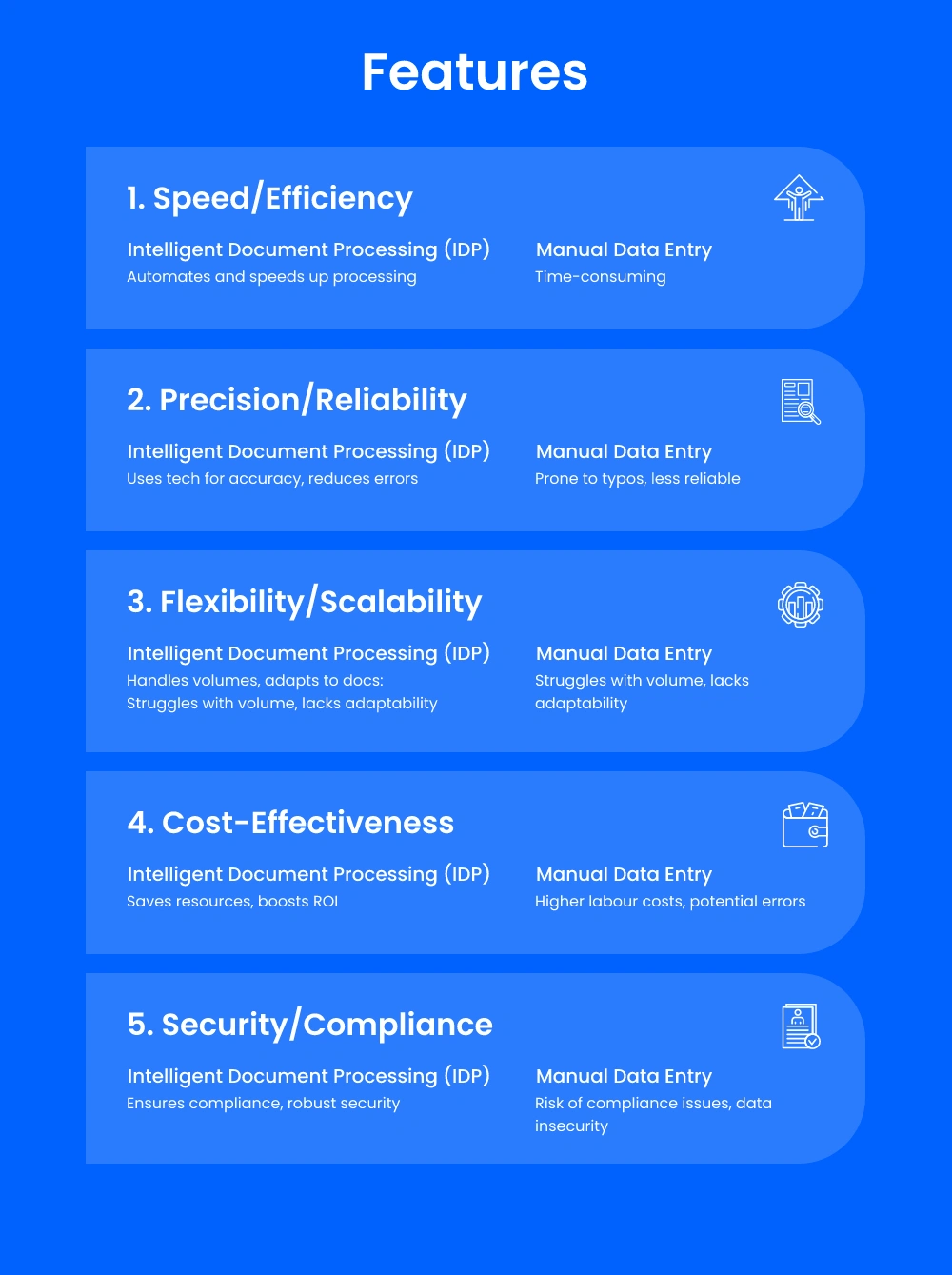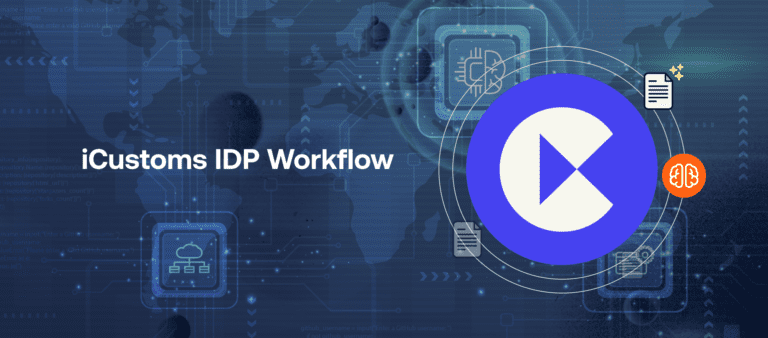AI That Simplifies Trade Compliance and Drives Growth
Intelligent Document Processing Software vs. Manual Data Entry
-
Freya Jane
- Director of Customer's Success
Choosing between Intelligent Document Processing software and manual data entry holds significant weight in the trades and customs sector, where precision and efficiency reign supreme. Today, businesses have a game-changing advantage with advanced technologies that streamline document handling and automate crucial procedures, marking a pivotal shift thanks to technological progress. Let’s look at the contrasting landscapes of IDP software and manual data entry in this specialised domain.
According to research by Raymond R. Panko, there is an 18% to 40% chance of a human error while manually entering data into spreadsheets and documents. This mistake rate rises much more for complicated customs documents.
Challenges of manual data entry in customs
Customs and trades face numerous challenges when entering data by hand, which makes the process less accurate, efficient, and less smooth overall. The following are some of the main issues:
Human error
- Typos and errors: Entering data is a time-consuming and repetitive process, which raises the possibility of errors, misreadings, and missing crucial information. These mistakes may result in fines, shipments being seized, and delays.
- Inconsistent formatting: Trade documents can be found in a variety of languages and formats, which makes it challenging to guarantee consistency in data entry and can cause processing delays.
- Fraudulent activity: Manual handling creates security risks and raises compliance issues by providing opportunities for criminals to tamper with data or falsify documents.
Time and resource consumption
- Processing delays: Entering data by hand takes a lot of time and can cause delays in company transactions, shipment deliveries, and customs clearance. This can have an influence on consumer satisfaction while also costing businesses time and money.
- Inefficient resource allocation: Large teams of data entry personnel are frequently needed, especially for high-volume trade transactions. This can be costly and reduce resources for other important tasks.
- Lack of real-time data: Manual processes slow down getting and analysing data, making it tough to make smart decisions or adapt to market changes or new laws in a timely manner.
Limited scalability
- Unable to manage higher volume: When trade volumes rise, manual data entry cannot keep up, leading to bottlenecks and backlogs. Adding more staff is necessary for scaling up, which raises expenses and puts more strain on available resources.
- Lack of interface with other systems: Manual data is frequently compartmentalised, making it difficult to combine with other customs and trade systems, restricting automation and data visibility.
- Decreased accountability and transparency in trade operations: Manual processes make it impossible to precisely audit data and adhere to shipment status, which further reduces transparency.
These difficulties underline the crucial importance of digitalisation and automation platforms in customs and trade. Businesses can increase the accuracy, efficiency, and scalability of their customs and trade operations by implementing technology such as IDP software and document automation tools.
Introducing Intelligent Document Processing Software: Enhancing Operational Efficiency
IDP is a process automation software that employs various technologies to replace manual data entry processes.
- OCR: IDP employs OCR to read and convert scanned documents or photos into machine-readable text, allowing for information extraction.
- ML: Over time, IDP software increases the accuracy of data extraction and classification by continuously learning from data patterns.
- NLP: By helping software comprehend the relationships, context, and meaning of text, NLP improves its capacity to extract pertinent data from unstructured texts.
IDP software: overcoming the challenges of manual data entry in customs
Data extraction from various documents
- Packing lists
- Bills of lading
- Certificates
- Invoices.
By reliably and consistently extracting relevant information from these documents, it ensures data consistency.
Automating customs forms and declarations
By automating the data extraction and input processes, this intelligent power automation tool simplifies the completion of customs forms and declarations. This automation considerably speeds up the clearance process, decreasing errors caused by manual entry.
Simplifying compliance checks
By comparing extracted data with accepted norms and rules, this software for document management guarantees regulatory accuracy. By reducing the chance of non-compliance, this capacity helps to prevent fines and shipment delays.
Improving data transparency and accessibility
This legal document automation software offers correct information in real time by centralising and digitising data. This provides immediate insights, powering business owners to make the right decisions.
Intelligent Document Processing Software vs. Manual Data Entry

The following list of salient features compares manual data entry with intelligent document processing (IDP) software:
Speed and efficiency
- IDP: The automation built into IDP software speeds up document processing. It quickly gathers, sorts, and organises data from a variety of documents, cutting down on the time needed to complete these operations.
- Manual data entry: Manual procedures are time-consuming and slow. Manual data entry requires a lot more time than intelligent automation software.
Precision and reliability
- IDP: IDP ensures greater accuracy in data extraction and processing by utilising technologies such as OCR, machine learning, and natural language processing. When compared to manual data entry, it reduces errors and produces more trustworthy data.
- Manual data entry: Typing data by hand is prone to mistakes, including typos, misreadings, and omissions, which can result in less accurate and potentially unreliable data.
Flexibility and scalability
-
IDP: This is intended to handle large amounts of documents efficiently. Its scalability enables it to adapt to different document kinds and volumes, ensuring efficiency even when workloads fluctuate.
-
Manual data entry: When handling massive volumes of data, manual approaches frequently result in bottlenecks and inconsistencies since they are unable to grow with the volume of documents.
Cost-effectiveness
-
IDP: IDP software boosts cost-effectiveness and yields a higher return on investment (ROI) over time due to increased efficiency and decreased operating expenses by automating tasks and saving time and resources.
-
Manual data entry: Using human labour alone for data input results in increased expenses related to work, time, and possible mistakes. This can lead to financial losses and a reduction in overall productivity.
Security and compliance
IDP: IDP uses standards-based data cross-referencing to guarantee accurate trade compliance with laws. It frequently includes strong security features as well to protect private data.
Manual data entry: Due to human mistakes or misinterpretation of regulations, manual techniques carry a higher chance of compliance issues. Furthermore, data security can be jeopardised if proper steps to protect information are not implemented.
Choosing the best intelligent document processing software
Selecting the best Intelligent Document Processing (IDP) software is critical for trades and customs, and iCustoms stands out for its unique features and capabilities. With its exceptional ability to integrate with current systems, iCustoms’ IDP software guarantees compatibility and a seamless transfer.
Furthermore, iCustoms’ IDP tool goes above and beyond basic options. It has configurable workflows that may be adjusted to meet certain business needs, guaranteeing efficient operations. The software prioritises strong security features, which protect important trade-related data. Its scalability also easily adapts to changing business requirements, enabling smooth expansion without sacrificing effectiveness.
When it comes to trades and customs, iCustoms’ IDP software stands out as a comprehensive solution. It provides robust security, scalability, customisable workflows, adaptability, and compliance, making it an excellent option for improving document management and expediting customs procedures.
FAQ's
What is the difference between manual and automated data entry?
Manual data entry includes humans entering data by hand, which is prone to errors. Automated entry relies on technology to increase efficiency and accuracy.
What is the difference between manual and automatic data processing?
Manual data processing requires human intervention, whereas automation processing uses technology for speedier, error-free procedures.
What is document processing vs intelligent document processing?
Document processing can be done manually or digitally, and intelligent processing automates operations to improve accuracy and efficiency.
Why is intelligent document processing important?
Intelligent document processing improves accuracy, speed, error reduction, and compliance while streamlining operations and increasing productivity.
You may also like:
Struggling to Extract, Catagorise & Validate Your Documents?
Capture & Upload Data in Seconds with AI & Machine Learning
Subscribe to our Newsletter
About iCustoms
Struggling to Extract, Catagorise & Validate Your Documents?
Capture & Upload Data in Seconds with AI & Machine Learning
